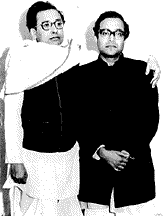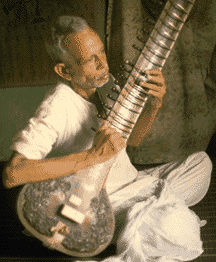
Nikhil Banerjee with Manilal, sixties. Collection Manilal Nag.

Nikhil Banerjee with Manilal, sixties. Collection Manilal
Nag.
Gharana, as the word suggests, is a school of thought or a particular
system or a style in music. Presentation of the same raga with
stylistic variations led to the origin of these gharanas or schools
of music. These gharanas formed the nucleus of demonstrative art.
The glorious heritage of Hindustani music, as we find it to this
day, has been preserved by great musicians of the past who have
handed down their rich resources in the classic tradition of guru-shishya
parampara, maintaining in each case the individual trends of their
gharanas.
The Vishnupur Gharana of Bengal has a prestigious past, the history
of which has little been revealed. Vishnupur, the town of Lord
Vishnu, is at present a subdivision town of Bankura district in
West Bengal. The historic name of the Rarh region of West Bengal
is Mallabhum. Though not vast in area, the region holds a significant
position in matters such as political vigour, civilization and
culture. Historians suggest that Mallabhum had once been the cultural
centre of Eastern India. Among its cultural achievements, music
had the highest honour. Here I am to discuss some features of
the Vishnupur Gharana, along with a few major historical references,
that have left indelible impressions upon the music of Bengal.
In the later part of the eighteenth century and towards the early
and mid-nineteenth century, when music of different gharanas were
gradually having their assimilation in the city-centre of Calcutta,
the dhrupad style flourished among the musicians of Vishnupur.
To recapitulate history, the Maharaja of Vishnupur was a contemporary
of Emperor Aurangzeb. The Senia Gharana was then in full bloom
and its reputation spread throughout India. Its influence on the
music of Vishnupur was enormous. It was around this time that
the famous dhrupad singer Bahadur Khan of the Senia Gharana, descendant
of Tansen, came at Vishnupur and made his gharana popular. The
next Maharaja of Vishnupur, Raghunath Singh Deo II, steered his
attention towards popularizing Bahadur Khan. At this time, the
Ustad expressed his desire to settle down in Vishnupur and the
Maharaja made all arrangements to honour him as his court singer.
The Maharaja also announced that anyone having a sweet voice and
interested in music could learn from Bahadur Khan without any
fees. He also bore the financial liability for the poor students.
In time, a good number of students became the disciples of Bahadur
Khan.

Manilal's father, Gokul Nag Photo: Ira Landgarten
Among the disciples of Bahadur Khan, the name of Gadadhar Chakravorty
is noteworthy. Bahadur Khan was not only a vocalist but could
also efficiently play on such instruments as the veena, the rabab
and the sursringar. Gadadhar Chakravorty learned from his master
both vocal and instrumental music. Among his worthy disciples
were such talents as Ram Shankar Bhattacharya and Jadu Bhatta,
whose name spread throughout India.
Most of the exponents of Vishnupur learned dhrupad song and instrumental
music simultaneously. Vishnupur was at that time the cultural
capital of India.
Shri Anantalal Banerjee of Vishnupur was an illustrious musician
who had his training from Shri Ramshankar Bhattacharya in both
vocal and instrumental music. Anantalal's sons, Shri Ramprasanna
Banerjee, Shri Gopeswar Banerjee and Shri Surendranath Banerjee,
were prodigies of this gharana. Shri Radhika Prosad Goswami, disciple
of Anantalal Banerjee, earned great fame as a dhrupad singer.
Among the students of Shri Radhika Prosad were Shri Girijashankar
Chakravorty, Jogendra Nath Banerjee and Dhirendra Nath Bhattacharya
who won their acclamation in the early conferences of Calcutta.
Sangeetacharya Tarapada Chakravorty, Jamini Ganguli, Sailen Banerjee
and many others learned from Girijashankar Chakravorty. Our great
poet, Rabindranath Tagore had his trainings in the dhrupad style
from Radhika Prosad Goswami and Jadu Bhakti of Vishnupur. The
dhrupad style of Vishnupur had a good deal of influence on many
of the songs composed by Tagore.
Shri Ramprasanna Banerjee, the guru of my father the late Gokul
Nag, also received his training from Sajjad Muhammed, son of Gulam
Muhammed. Sajjad Muhammed was then staying at Jorasanko Rajbati
of Raja Sourendra Mohan Tagore of Calcutta. During that time Shri
Nilmadhab Chakravorty, the grandson of Gadadhar Chakravorty was
teaching Raja Jotindra Mohan Tagore. Ustad Allauddin Khan of Maihar
took his lessons in surbahar from Shri Nilmadhab Chakravorty.
Shri Ganendra Prosad Goswami, the nephew of Radhika Prosad Goswami
was a very famous musician. He recorded many songs for the Gramophone
Company of India.
I have mentioned before the name of Shri Gopeswar Banerjee, a
great pioneer of the music of Vishnupur. He was the court musician
of the Maharaja of Burdwan, Narajol and Mayurbhanj. He wrote a
number of books on musicology as Sangeet Chandrika, Geet-Darpan,
Geet-Praveshika, Sangeet Lahari and others. Shri K. C. Dey, the
uncle of Manna Dey, the popular light music singer of Bengal,
also learned dhrupad from Shri Gopeswar Banerjee. Kshetramohan
Goswami, another maestro in this area, was a disciple of Ramshankar
Bhattacharya. It was he who invented the Dandamatrik system of
notation in Bengal.
Until a few years ago the name of the late Satyakinkar Banerjee
was well-known among the music lovers of Calcutta. Besides vocal
music, he was adept in surbahar and sitar: the late Pandit Nikhil
Banerjee and myself, have listened to his playing in his house
at Calcutta. His sons, Shri Amiya Ranjan Banerjee, ex-professor
of Rabindra Bharati University, Shri Nihar Ranjan Banerjee, Professor
of Rabindra Bharati University and Shri Monoranjan Banerjee, are
now representing the Vishnupur Gharana, almost in its twilight
days, bearing just a few glimpses from its age-old tradition.

Manilal's sitars Photos by Ira Landgarten
I would like to draw the conclusion of my discussion with this
opinion that, although every gharana has its own distinctive style
of presentation, no creative art can develop within any rigorous
binding. Music is the highest among fine arts. Every individual
has his own build-up of the mind, his own environmental influences
that will leave remarkable traces upon his music. Through his
creation the artist, in a sense, manifests his soul - the Atma.
While presenting his art, he is in a state of emotional exaltation.
Hence, two artistes, belonging to the same gharana, need not necessarily
have the same way of presentation. Variations must be accepted,
otherwise creative music would have become identical with composed
music. The artiste's quest should not be after what genre he belongs
to but after what he is. -- A paper presented by Pandit Manilal
Nag at the Seminar on Sitar organized by the Sangeet Research
Academy, 23 September 1990, Bombay.